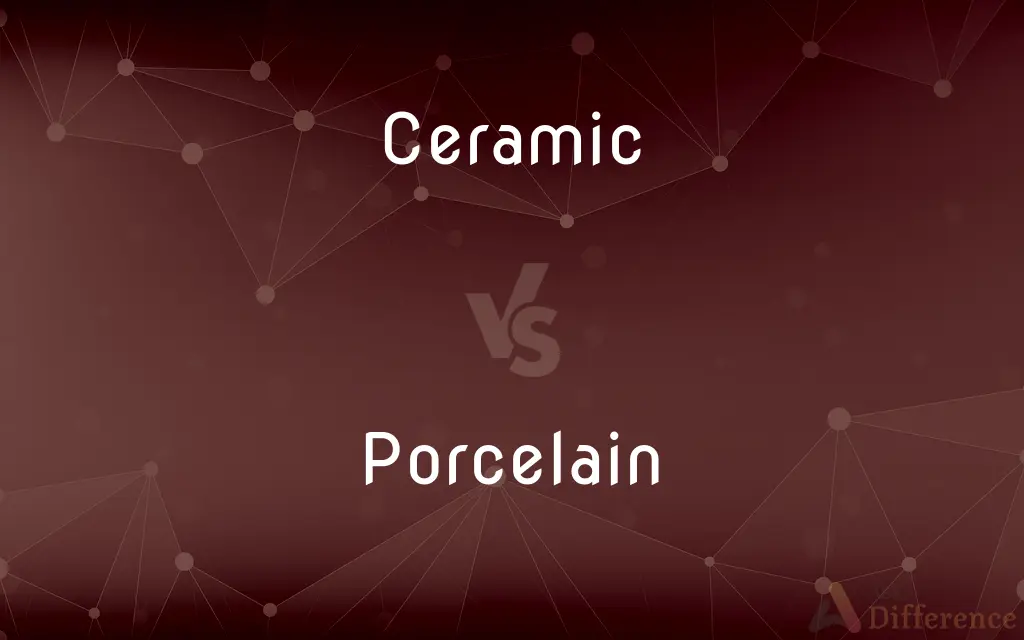Ceramic vs. Porcelain — What's the Difference?
Edited by Tayyaba Rehman — By Urooj Arif — Updated on April 15, 2024
Ceramic refers to various inorganic, non-metallic materials fired at high temperatures, while porcelain is a specific, highly refined type of ceramic known for its strength and translucency.

Difference Between Ceramic and Porcelain
Table of Contents
ADVERTISEMENT
Key Differences
Ceramic materials are diverse and include earthenware, stoneware, and porcelain, whereas porcelain is a specific kind of ceramic characterized by its fine texture and durability.
Ceramic products are generally less dense and more porous than porcelain, which is known for its high density and low porosity due to being fired at higher temperatures.
In terms of appearance, ceramics offer a wide range of finishes and textures, while porcelain typically features a smooth, glass-like surface that can be either glossy or matte.
The production process of generic ceramic items usually involves lower firing temperatures compared to porcelain, which requires high temperatures that vitrify the clay to create a glassy, impermeable surface.
Due to its strength and moisture resistance, porcelain is often used in applications requiring durability such as in flooring and sanitary ware, whereas ceramics are more commonly found in less demanding decorative applications.
ADVERTISEMENT
Comparison Chart
Composition
Varied clay compositions
Fine-particle clay, highly refined
Firing Temperature
Lower, varies by type
Very high, typically above 1200°C
Density and Porosity
Generally more porous and less dense
Highly dense and less porous
Typical Uses
Decorative items, pottery
Flooring, high-quality dinnerware
Surface Finish
Matte, glossy, textured
Typically glossy and smooth
Compare with Definitions
Ceramic
Made of clay and hardened by heat.
The ceramic vase features a colorful, hand-painted design.
Porcelain
A type of ceramic made from a refined clay and fired at high temperatures.
Porcelain tiles are popular for their durability and sheen.
Ceramic
Involving the production of goods made from non-metallic minerals.
She specializes in ceramic sculpture.
Porcelain
Capable of being produced in various colors and designs.
Modern porcelain vases come in an array of contemporary styles.
Ceramic
Pertaining to the art of making objects by firing them in a kiln.
Ceramic classes teach the fundamentals of clay manipulation.
Porcelain
Known for its strength, translucency, and smooth surface.
Porcelain figurines are prized for their delicate appearance.
Ceramic
Fragile and susceptible to cracking.
Handle ceramic dishes with care to avoid breakage.
Porcelain
Often used in making high-quality tableware and decorative objects.
The dinner party featured an elegant set of porcelain china.
Ceramic
Resistant to high temperatures.
Ceramic coatings are often used to protect engines from heat.
Porcelain
Impervious to water, making it ideal for bathroom fixtures.
Porcelain sinks are preferred for their long-lasting finish.
Ceramic
A ceramic is any of the various hard, brittle, heat-resistant and corrosion-resistant materials made by shaping and then firing a nonmetallic mineral, such as clay, at a high temperature. Common examples are earthenware, porcelain, and brick.
Porcelain
Porcelain () is a ceramic material made by heating materials, generally including a material like kaolin, in a kiln to temperatures between 1,200 and 1,400 °C (2,200 and 2,600 °F). The strength, and translucence of porcelain, relative to other types of pottery, arises mainly from vitrification and the formation of the mineral mullite within the body at these high temperatures.
Ceramic
Made of clay and permanently hardened by heat
A ceramic bowl
Porcelain
A hard, white, translucent ceramic made by firing a pure clay and then glazing it with variously colored fusible materials; china.
Ceramic
Pots and other articles made from clay hardened by heat
Many of the painted ceramics are of native manufacture
Porcelain
An object made of this substance.
Ceramic
Any of various hard, brittle, heat-resistant and corrosion-resistant materials made by shaping and then firing a nonmetallic mineral, such as clay, at a high temperature.
Porcelain
A hard white translucent ceramic, originally made by firing kaolin, quartz, and feldspar at high temperatures but now also inclusive of similar artificial materials; also often (figurative) such a material as a symbol of the fragility, elegance, etc. traditionally associated with porcelain goods.
Tableware and toilets are both made of porcelain.
Ceramic
An object, such as earthenware, porcelain, or tile, made of ceramic.
Porcelain
Syn of china: porcelain tableware.
He set the table with our porcelain and stemware.
Ceramic
Ceramics (used with a sing. verb) The art or technique of making objects of ceramic, especially from fired clay.
Porcelain
Syn of kaolin: the kind of clay traditionally used in China to manufacture porcelain.
Ceramic
Made of material produced by the high-temperature firing of inorganic, nonmetallic rocks and minerals.
A ceramic vase stood on the table.
Porcelain
An object made of porcelain, (particularly) art objects or items of tableware.
The museum has an extensive collection of rare Chinese porcelains.
Ceramic
(uncountable) A hard, brittle, inorganic, nonmetallic material, usually made from a material, such as clay, then firing it at a high tempature.
Joan made the dish from ceramic.
Porcelain
Syn of cowrie.
Ceramic
(countable) An object made of this material
Joe had dozens of ceramics in his apartment.
Porcelain
Syn of wampum: strings of shells, beads, etc. used as ornamentation or currency; the composite shells, beads, etc.
Ceramic
Of or pertaining to pottery; relating to the art of making earthenware; as, ceramic products; ceramic ornaments for ceilings.
Porcelain
A kind of pigeon with deep brown and off-white feathers.
Ceramic
An artifact made of hard brittle material produced from nonmetallic minerals by firing at high temperatures
Porcelain
Purslain.
Ceramic
Of or relating to or made from a ceramic;
A ceramic dish
Porcelain
A fine translucent or semitransculent kind of earthenware, made first in China and Japan, but now also in Europe and America; - called also China, or China ware.
Porcelain, by being pure, is apt to break.
Porcelain
Ceramic ware made of a more or less translucent ceramic
Common Curiosities
Are all ceramics fragile?
Many are, but the degree of fragility varies with the type and production process.
Can ceramic materials withstand outdoor conditions?
It depends on the type; some ceramics are more durable and suitable for outdoor use than others.
What are the best uses for porcelain in home decor?
Flooring, bathroom fixtures, and high-quality ornamental pieces.
How does porcelain differ from other ceramics?
Porcelain is made from finer clay and is fired at higher temperatures, making it denser and less porous.
Why is porcelain considered ideal for dinnerware?
Its strength, water resistance, and aesthetic appeal make it suitable for fine dining occasions.
Is porcelain environmentally friendly?
Like other ceramics, it is inert and non-toxic, but its production is energy-intensive.
Do ceramics have health implications?
They are generally safe, but lead-based glazes (now largely discontinued) were a concern in the past.
What defines a material as ceramic?
Ceramics are non-metallic, inorganic materials that are hardened by heat.
What innovations are there in ceramic technology?
Advances include improved durability, enhanced thermal properties, and more diverse aesthetic options.
How should porcelain be maintained?
It requires minimal maintenance, though gentle cleaning is recommended to preserve its finish.
How are ceramic items typically decorated?
Through glazing, painting, and sometimes carving.
What makes porcelain a premium material?
Its durability, smooth finish, and elegant translucency.
Can ceramics be recycled?
While difficult to recycle traditionally, some ceramics can be crushed and reused in other applications.
What is the cultural significance of ceramics and porcelain?
Both have rich histories in various cultures, especially in pottery, art, and architecture.
What is the cost comparison between ceramic and porcelain?
Porcelain generally tends to be more expensive due to its superior qualities and manufacturing requirements.
Share Your Discovery

Previous Comparison
Hummingbird vs. Sunbird
Next Comparison
Change vs. CashAuthor Spotlight
Written by
Urooj ArifUrooj is a skilled content writer at Ask Difference, known for her exceptional ability to simplify complex topics into engaging and informative content. With a passion for research and a flair for clear, concise writing, she consistently delivers articles that resonate with our diverse audience.
Edited by
Tayyaba RehmanTayyaba Rehman is a distinguished writer, currently serving as a primary contributor to askdifference.com. As a researcher in semantics and etymology, Tayyaba's passion for the complexity of languages and their distinctions has found a perfect home on the platform. Tayyaba delves into the intricacies of language, distinguishing between commonly confused words and phrases, thereby providing clarity for readers worldwide.














































